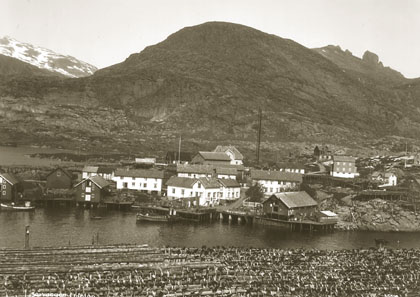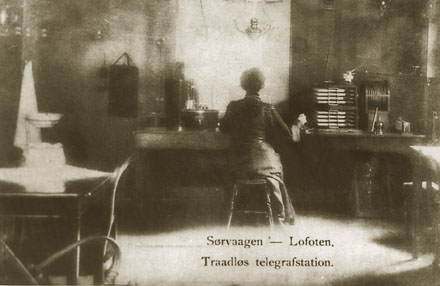 NORWEGIAN TELECOM MUSEUM,
SØRVÅGEN
NORWEGIAN TELECOM MUSEUM,
SØRVÅGEN
8392 Sørvågen. Tel. (+47) 76 09 14 88



135 Years of Sørvågen Telegraph Station and Sørvågen Radio
 We might well reflect in wonder at the fact that such a long, drawn out and craggy country as ours, on the outskirts of Europe, can offer telecommunications services to meet the highest of standards.
We might well reflect in wonder at the fact that such a long, drawn out and craggy country as ours, on the outskirts of Europe, can offer telecommunications services to meet the highest of standards.
Many may indeed ask why Sørvågen, in the western Lofotens, set in Norway’s perhaps wildest and most rugged landscape, was to become the scene where such extremely important chapters in the history of Norwegian and European telecommunications history were written.
Or might this inaccessible countryside itself provide the reason why Norway is today among the world leaders in the development of telecommunications ?
Sørvågen Telegraph Station and Sørvågen Radio have been very much in the limelight throughout the 150 years of our telecommunications history.
(Illustration shows Sørvågen Radio, 27.5.1930. Photo: Wilse. Norwegian Folk Museum)
Why Lofoten – Why Sørvågen?
Every winter, fish worth millions of kroner were landed in Lofoten. The Lofoten fishery was one of the country’s most important enterprises. It was believed that establishing telegraph and telephone services in Lofoten would lead to an increase in the country’s income. Therefore, the authorities invested in the development of telegraph lines in Lofoten, starting in 1860.
Wild mountains and ocean currents prevented the extension of the telegraph lines from Sørvågen, to Røst, Værøy and the Lofoten headland. The village of Sørvågen was therefore selected as the venue where several new inventions were to be tried out.
Norway’s First Fisheries Telegraph Service – 1861
The year is 1859. Director General Motzfeldt of the post office wrote in his report from the Lofoten fishery that the yield would have been increased by 25% had telegraph lines been extended to the fishing villages. The Norwegian parliament – Stortinget – subsequently granted funds for a telegraph line to Lofoten. The Lofoten Line was completed in 1861, and its 170 kilometres of undersea cables and land lines comprised the country’s first separate telegraph line that was independent of the main network. Nine fishing villages had now been connected to each other by telegraph lines during the Lofoten fishing season. These were Skrova, Brettesnes, Svolvær, Ørsvåg (moved to Kabelvåg in 1862), Henningsvær, Steine, Ballstad, Reine and Sørvågen. The stations were only open during the fishing season, from January to April. In 1868, the Lofoten Line was linked up to the main Norwegian network, and from 1873, Sørvågen Telegraph Station was open all year round.
This increased the yield of the Lofoten fishery for both the fishermen, the merchants and the state, while also creating many new jobs in the fishing villages. It was now possible to swiftly redirect the bait boats to where they were needed most, to transmit news about where the fishing was at its best, and to forecast stormy weather before it was too late.
Northern Europe’s First Wireless Telegraph – 1906
"The mast was 50 metres tall. One of the workers climbed up and lay flat on his stomach across the top of it. I remember it well. We stood there with our hearts in our mouths," old Mrs. Hjørdis Lie from Sørvågen recalled.
We have moved on to 1903. On Lillehaugen hill in Sørvågen, a tall mast, comprising of several fir logs joined together and secured with 28 stays, had been raised. Similar masts had been set up on the islands of Værøy and Røst. The world’s second permanent wireless telegraph station had been built for experimental operations. Would it be possible to telegraph across the dreaded Maelstrom without laying one single undersea cable?
Four years earlier, in 1899, Marconi of Italy had experimented with wireless telegraphy across the English Channel.
The fishermen and squires of the western Lofotens realised straight away what significance "the wireless" would have for them.
Elation in Røst – And a Long Way to Row
In 1902, Hermod Petersen, an engineer from the Telegraph Board, paid a visit to Sørvågen. He spent the night at squire Nils Arntzen’s, assessed conditions, and left, convinced that it would be possible to establish a wireless connection between Værøy and Røst, and Sørvågen, that is to say, between the whole of Lofoten and the rest of the country. The Storting granted 15,000 kroner to the project.
The experiments carried out in 1903 provided results beyond all expectations. It is said that a man rowed all the way from Røst to Sørvågen, a stretch of 60 kilometres across perilous waters, to bring the good news: the signal from Sørvågen had passed over the Lofoten mountains, traversed the Maelstrom and been picked up in Røst.
On May 1, 1906, the wireless link between Sørvågen and Røst was officially opened – Northern Europe’s first wireless telegraph. The Italians had got theirs the year before, but at least Sørvågen came in at second place in these worldwide statistics.
Storms and War – The Masts the Weakest Link
Even before the telegraph line had been officially opened, the masts had been damaged by stormy weather. The top of the Røst mast was blown down on February 6, 1906. On March 11 it broke again, and on April 11, the top of the mast at Sørvågen was blown down. Even the new iron mast raised at Sørvågen in 1914 was blown down in 1925.
During the Second World War, Sørvågen Radio became a very important link in the German communications network, and on Boxing Day in 1941, the mast was demolished by British commandos during the raid on Lofoten.
Kaiser Wilhelm – Contact with Ships at Sea – 1908
"I remember Kaiser Wilhelm’s ship, the "Hohenzollern" was moored just off shore here. We kids were so excited. We climbed the hill and saw a little boat come to shore with a telegram," says Mrs. Hjørdis Lie. The clerks at the telegraph office did everything within their power to provide the Kaiser with the best possible service, but it was all in vain.
Telegraph manager Øwre wrote the following in his telegram protocol:
July 15, 1906: "... have extra assistance today in connection with the German Kaiser’s journey south ... do not disturb Sørvågen’s possible coming correspondence with the ship."
July 16, 1906: "Heard a sign from the ship yesterday ... dispatched a number of telegrams ... the state of the network here, and the low mast made adjustments very difficult . I regret that this may provide an incorrect impression of both the equipment and those operating it."
July 12, 1907: "Called the "Hohenzollern" from 6 in the morning until 10.15 without being heard. We heard the ship call Sørvågen 10 times and Røst 4 times."
Sørvågen, then, did not manage to make contact with the Kaiser’s ship. This was an embarrassment for the as yet young nation of Norway. However, not only did Kaiser Wilhelm launch the flow of German tourists to Lofoten, we can also thank him for the fact that the telegraph office in Sør-vågen was opened for contact with ships at sea as early as on July 1, 1908, making it the first of its kind in Norway.
Increased Traffic
The telegraph office became more and more important to the fisheries. During the Lofoten fish-ing season in 1910, up to 500 telegrams a day might be dispatched here. There was, of course, considerably less traffic during the off-season.
The telegraph station in Sørvågen soon became too small, but in 1914, station manager Thorleif Johannesen was able to move with his family and all his equipment into the new and pleasant telegraph building, only a few hundred metres away from the old station.
Wireless Telephone to Hell and the Maelstrom – 1928
Norwegian Telecom obtained their first wireless telephone sets (radiotelephony) in 1919. The ordinary telephone lines now met with competition, just as the telegraph lines had been with the advent of wireless telegraphy.
Norway’s first radio telephone station was also established in conjunction with Sørvågen Radio.
Lofotodden Radiotelephony Station at Hell began corresponding with Sørvågen in 1928. A few years later, Værøy also obtained a similar connection with Sørvågen.
Some important chapters in the history of telegraphy were indeed written in Sørvågen. It is sad that in 1976-77, the station had to be automated and Sørvågen Radio was closed down. The four telegraph buildings that had been in use from 1861 are still in relatively good condition, as is the 70 metre tall radio mast. The people in the west of Lofoten still appreciate the light emitted from it on dark autumn and winter nights.
The Sørvågen Telecom Museum was opened in May 1996, as a division of the Norwegian Telecommunications Museum. The museum provides a good impression of the development of telegraphy, telephony and radio in this country.
The museum is housed in the old telegraph station which dates back to 1914 and is situated just off the E10 highway.
The exhibitions will be closely linked to the following landmarks in the history of telecommunications in Lofoten and Norway:
• Norway’s first fisheries telegraph service, the Lofoten Line, 1861
• Northern Europe’s first permanent wireless telegraph service, 1906
• Norway’s first permanent ship’s telegraph, 1908
• Norway’s first permanent wireless telephone (radiotelephone), 1928
• Norway’s first permanent radio link, 1946
The above text is an extract from the book "Guide to the History of Lofoten" which is available for purchase from the museums, local shops and the
Tourist Information Centre. 136 pages, available in English, German and Norwegian. Price NOK 149,-
Click here to download out brochure in PDF-format
(408 kb).
Welcome to the Norwegian Telecom Museum,
Sørvågen, Lofoten Islands
More info about the Norwegian Telecom Museum
Home Page
Flakstad og Moskenes offisielle hjemmeside.
Museene i Flakstad & Moskenes